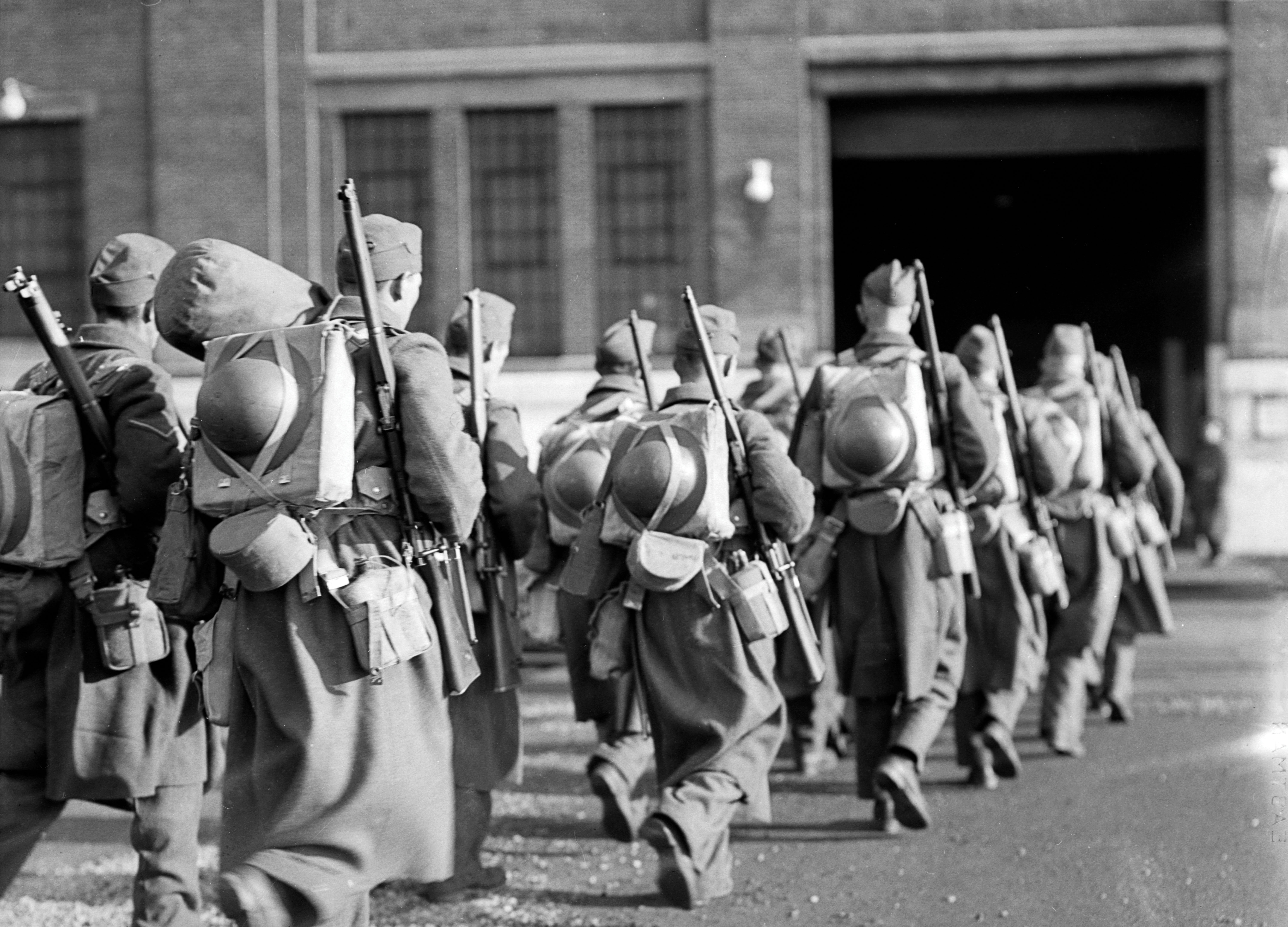
The 1st Division of the Canadian Active Service Force departs Halifax for overseas in December 1939. Ten thousand Canadian Militia members had been mobilized in August. [F.C. Tyrell/DND/LAC/PA-163405]
Over the next eight months, the only military land operation on the Western Front was France’s Saar Offensive, a short-lived incursion across Germany’s western border. This ominously quiet period came to be called the “Phoney War”—a term believed to have been coined by American senator William Borah.
The invasion of Poland happened a week after Germany and the Soviet Union had signed a non-aggression pact. By the middle of September, the Wehrmacht had crushed most Polish resistance and met up with the Red Army in eastern Poland. London and Paris began to move their armies toward the German border but took no significant action to assist the Poles.
Winston Churchill returned from the political wilderness in London, joined Prime Minister Neville Chamberlain’s cabinet and became First Lord of the Admiralty. A few days later, Britain implemented merchant ship convoys. For a while, the only war waged by France and Britain was an economic one, consisting mainly of naval blockades and the purchase of war materiel from neutral countries to prevent Germany from stocking up.
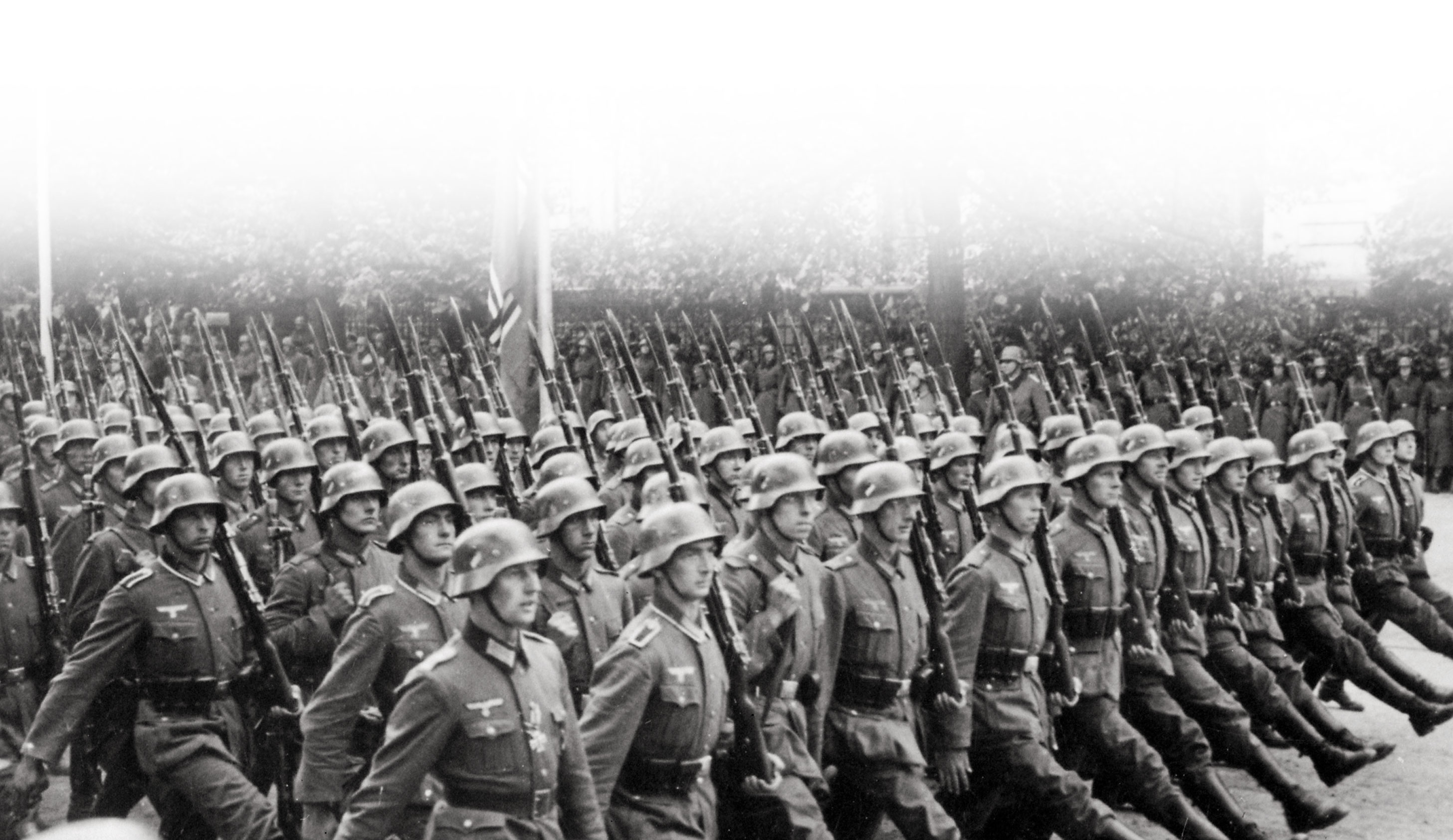
German troops parade through Warsaw, Poland, following the Nazi invasion of Sept. 1, 1939. [U.S. National Archives]
In Canada, the Liberal government of Prime Minister Mackenzie King had ordered the precautionary mobilization of some 10,000 Canadian Militia members on Aug. 24. Their mission was to provide port defence on both coasts and to guard “vulnerable points” inland.
After learning of the Nazi invasion of Poland, the government invoked the War Measures Act on Sept. 3, placed the regular forces on active service and authorized the call-up of reserves.
King dreaded the approach of war, fearing real division between French- and English-speaking Canadians, but his policy of obfuscation and delay and his promises that there would be no conscription for overseas service and that “Parliament will decide” produced a near-unanimous decision in the House of Commons on Sept. 9 that Canada should go to war.
On Sept. 10, King George VI declared war on Germany on behalf of Canada. A year earlier that had seemed an impossibility.
The prime minister soon made the government’s priorities clear. This was to be a war of limited liability. Canada would not tear itself apart, as it had in the Great War, by implementing conscription for overseas service. The nation’s first priority was to be the defence of Canada. Initially, King hoped that Canada might not even send troops overseas, and he had slapped down the chiefs of staff who presented plans to deploy a 60,000-man expeditionary force to Europe. He also ordered the finance department to reject any defence department request for funding for anything other than the defence of Canada.
Defence minister Ian Mackenzie directed his officials not to stimulate recruiting, but men still flooded the recruiting stations, and by the end of September, the army had enlisted almost 55,000. That must have surprised the prime minister.
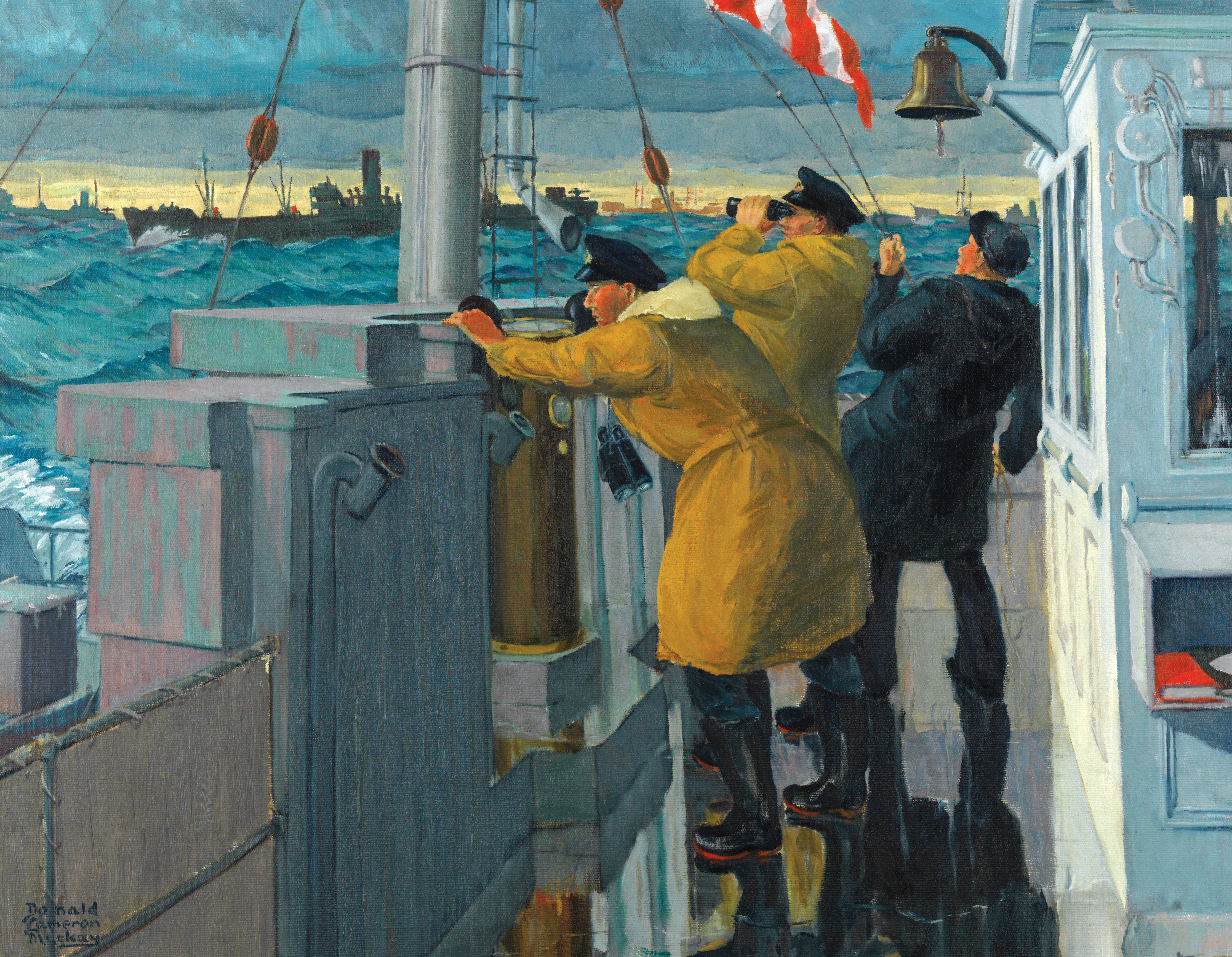
Crew on the open bridge of HMCS Galt scan for German U-boats while escorting a convoy of merchant ships. Wartime supply lines to Britain started with the outbreak of war. [Donald MacKay/CWM/19710261-4211]
Even before the Canadian declaration of war, King was surprised to find that his cabinet wanted the country to raise and dispatch one infantry division overseas and have another in Canada. King reluctantly agreed. The defence minister announced this decision on Sept. 19, in his last act in that portfolio. He was then shuffled off to be minister of pensions and national health and replaced by minister of labour Norman Rogers.
There was no money in Depression-wracked Canada, and to send even one division overseas and raise another for possible service might be more than the country could do.
“[A] third division could not be thought of at this time,” King wrote in his diary, “if we were not to occasion protest across the country itself and even more impair the credit of Canada.”
King’s reluctance to fight was reflected in the public mood. On the University of Toronto campus, for example, “there was no reflexive outburst of patriotic enthusiasm, no rush to get overseas, no repetition of the scenes that had made the fall of 1914 so memorable,” noted the historian of the university’s contingent of the Canadian Officers’ Training Corps.
Certainly, there was strong neutralist sentiment in academe and the churches, and many Canadians who remembered the horrors of 1914-18 wondered if this was Canada’s war. Why should Canada be the only Western Hemisphere nation to voluntarily go to war at a time when the Great Depression still held the nation in its clutches? Wasn’t this only another war of rival imperialisms?
It wasn’t, but it would take time for Canadians to realize this.
Canada’s armed forces were desperately underfunded at the outbreak of the war. Appropriations for the Department of National Defence had been $26.7 million in 1934-35 and had risen only to $36.3 million by 1938-39. The army was desperately weak. The militia had some 50,000 officers and men on its rolls, but it was almost completely untrained and ill-equipped, without modern weapons or vehicles.
In 1939, the army had four anti-aircraft guns, five mortars, 82 Vickers machine guns and 10 Bren guns. The Permanent Active Militia, only marginally better trained than the Non-Permanent Active Militia, numbered only 4,169, including 446 officers, many too old or unfit for overseas service. (The two forces were reorganized into the Canadian Army in November 1940.)
If the army was weak, the Royal Canadian Navy was even less prepared. The first contracts for the construction of 10 corvettes were issued in February 1940. Until they were ready, the RCN’s major fleet units consisted of six destroyers and four minesweepers, and the service’s complement at the outset of the war was 1,850 ratings, 131 officers and approximately 1,500 reservists.
Two destroyers on the West Coast received orders to proceed at speed to Halifax. The first convoy, HX-1, left Canada in the afternoon of Sept. 16, protected by two Royal Navy cruisers and two RCN destroyers. Overhead, two Royal Canadian Air Force Supermarine Stranraer flying boats from RCAF Station Dartmouth offered daylight protection.
The Athenia sinking had made it clear that U-boats were at sea, and there also were rumours of German pocket battleships hunting merchantmen. One of those, Germany’s armoured cruiser Admiral Graf Spee, was scuttled in shallow water off the port of Montevideo, Uruguay, on Dec. 18 after being badly damaged in the first major sea battle with the RN.
The RCAF had only 195 aircraft. Most were obsolete, although there were some modern Hawker Hurricane fighters. Personnel in the regular force numbered 4,000, including 235 pilots, some two dozen staff officers and 1,500 reservists organized in auxiliary squadrons. Several hundred Canadians were serving in the RAF, but no Canadian squadrons were in operations overseas during the Phoney War. If ever a nation was unready for war, Canada was it.
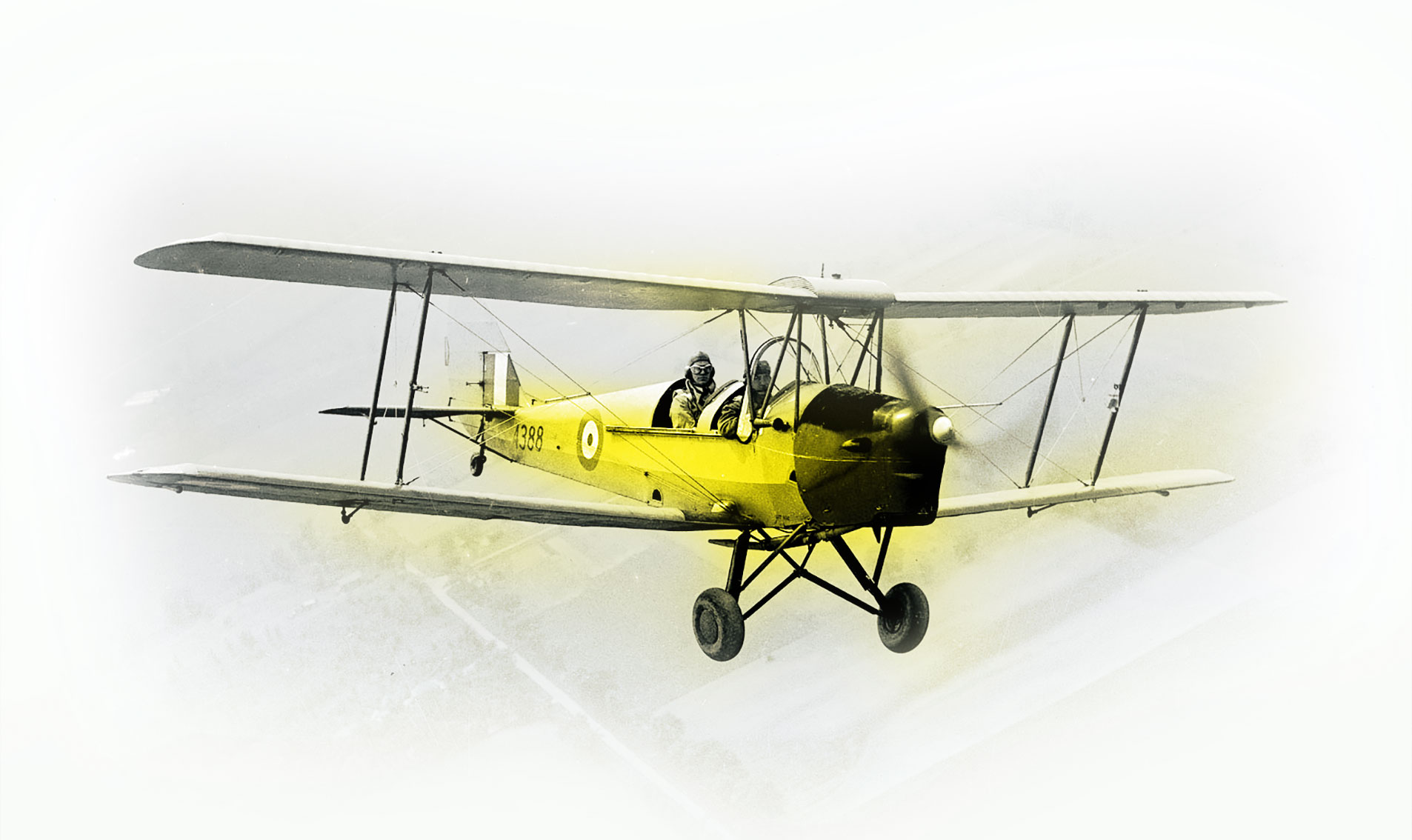
A Tiger Moth flies from No. 1 Elementary Flight Training School at RCAF Malton in Ontario. Most pilot trainees in the British Commonwealth Air Training Plan started out in the legendary biplane. [DND/PL-3582]
Public opinion in Quebec had reluctantly acquiesced to war only so long as recruitment was to be voluntary. Premier Maurice Duplessis and his Union Nationale party decided to seize the opportunity of war to seek a renewed mandate. Dissolving the legislature on Sept. 25, the premier declared that the war had given Ottawa the excuse it needed to centralize power and assimilate francophone Quebec. Essentially, Duplessis was challenging Ottawa’s decision to fight, and his election provoked near-panic in the Liberal government.
Despite King’s pleas that they not do this, his ministers in Quebec decided to tackle Duplessis head-on and threaten to resign if he won. That, the ministers said, would guarantee conscription, and the only way to stop this was to install a Liberal government in Quebec City and keep the federal ministers in the Cabinet. The ministers’ appeals and strong campaign worked, and Duplessis’ party was crushed by the provincial Liberals. The King government had survived the first challenge to the federal government’s policy.
At the same time, Ottawa was in difficult negotiations with Britain on the creation of a massive pilot-training program. London had been trying for some years to persuade the King government to permit the RAF to run a recruitment and training scheme for Canadians in Canada.
Fearing that Canadian autonomy might be jeopardized, the government had refused. But war with Germany changed that. Ottawa became interested in, indeed very keen on, such a plan, especially if the British would state that it would be Canada’s greatest contribution to the war effort. Prioritizing the air force would be a guarantee that conscription would be unnecessary, or so King hoped. In September 1939, no one could conceive of air force casualties ever being very high.
Still, the negotiations on what became the British Commonwealth Air Training Plan were contentious. London wanted Canada to pay most of the estimated $888.5-million cost to produce 20,000 pilots and 30,000 aircrew a year from across the British Commonwealth, a project that required 90 flying schools. Given that Canada’s contemplated defence expenditure was only $300 million a year, this colossal sum seemed impossible for the government to contemplate.
Negotiations dragged on into mid-December, almost foundering on Canadian efforts to have separate RCAF squadrons overseas with much of the cost paid by Britain. The end result was that Canada agreed to pay $353.4 million, Britain $185 million, Australia $39.9 million and New Zealand $28.6 million. Now the tiny RCAF would run the pilot-training program, a gigantic task. The announcement of the plan on Dec. 17—King’s 65th birthday—was the most significant event of the Phoney War in Canada.
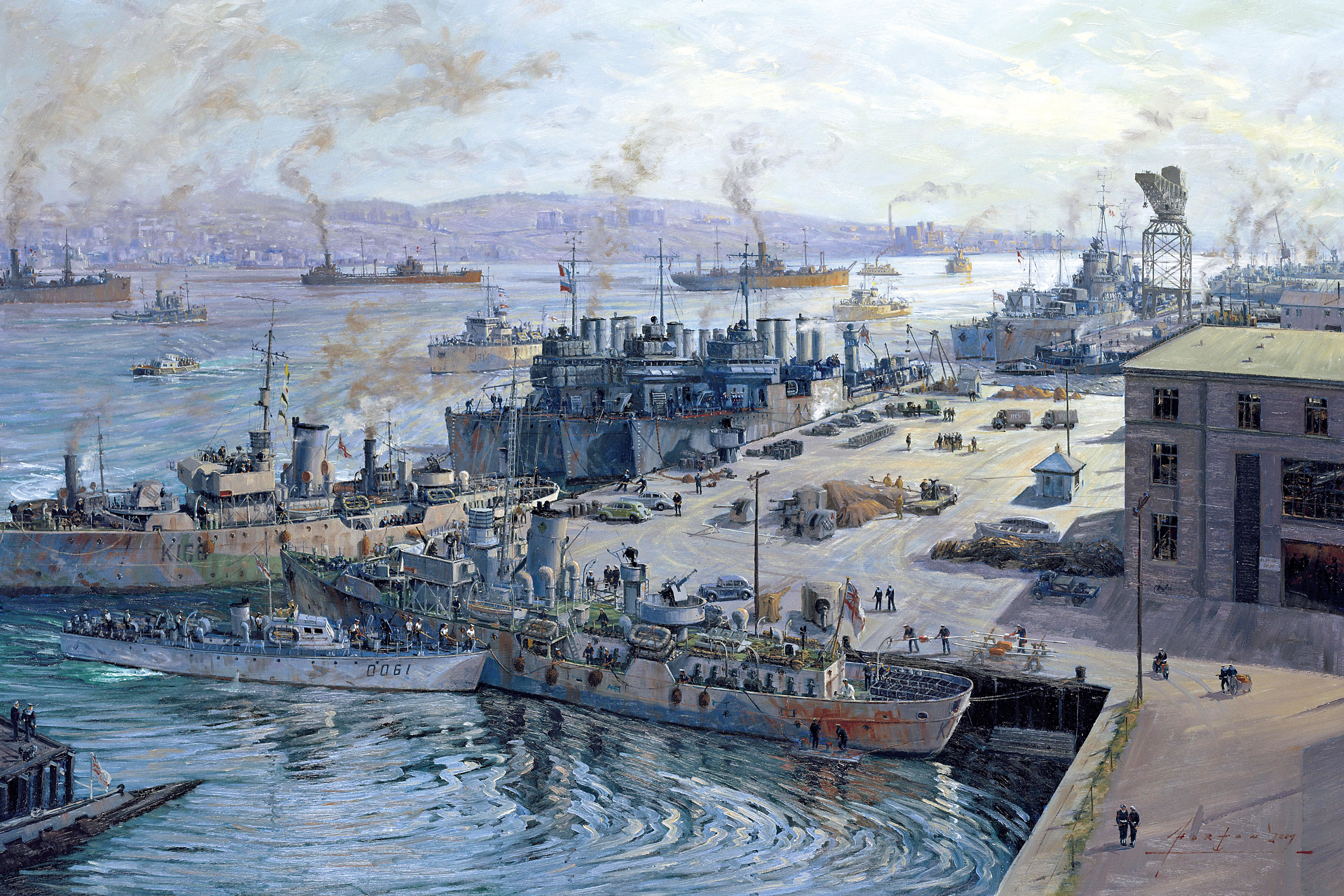
Halifax Harbour bustles with wartime naval activity in “The Springboard,” a painting by John M. Horton. Thanks to its proximity to the transatlantic route, the harbour was an important staging area for British-bound convoys. [John M. Horton/DND]
While the air-training negotiations dragged on, the army was remobilizing, according to a plan prepared by Brigadier Harry Crerar at headquarters in Ottawa. First Canadian Infantry Division was to include the three permanent force infantry battalions, one for each brigade, along with militia units with good records.
The brigades were geographically based, one each from Ontario, the West, and Quebec and the Maritimes. (When Britain declared war, Newfoundland, still a Crown colony, went to war too, forming a defensive home guard. To fight overseas, Newfoundlanders and Labradorians enlisted in British and Canadian forces.)
Two of the Canadian brigades were commanded by militia officers and the third was led by George Pearkes, VC, of the permanent force. Most of the remaining key staff appointments were filled by permanent force officers.
To command the division, the government chose Major-General Andrew McNaughton, 52, a distinguished and charismatic Great War artilleryman, former chief of the general staff and, at the time, head of the National Research Council. McNaughton was thought to be a Tory and this appointment, proving partisan politics weren’t at play, pleased the prime minister.
McNaughton’s task was to get the division equipped and trained. Neither was easy. The units were scattered across the country and would not be concentrated. Equipment, ranging from uniforms to weapons, was in short supply. When the commanding officer of the Royal Montreal Regiment had Eaton’s department store provide boots, he discovered that Ottawa refused to pay, until McNaughton, on a visit to the unit, approved the purchase on the spot. This proved to the soldiers that he would always do the sensible thing.
But McNaughton could not do the same with the division’s heavy weapons, all of which were to be provided in England. Canada could have supplied its own trucks, but the War Office insisted British manufacturers get the contract to supply them. Evidently, the idea of a limited liability war was not confined to Canada.
Early in December, the officers and men of the 1st Canadian Infantry Division boarded trains for Halifax and embarked for Britain. As in 1914, they were largely raw troops. “We didn’t know a damned thing,” recalled one Royal Canadian Engineer officer. Once again, Canada sent its soldiers overseas with nothing but uniforms and small arms.
The Canadians started training in earnest at the long-established British Army camp at Aldershot, Hampshire, in January 1940. This was followed by unit collective training in March and brigade and division exercises in April.
That schedule suited the War Office, which hoped to use the division at the front in May. Some units trained hard, others did not, and there was little direction from division headquarters. The Canadians were not ready for battle.
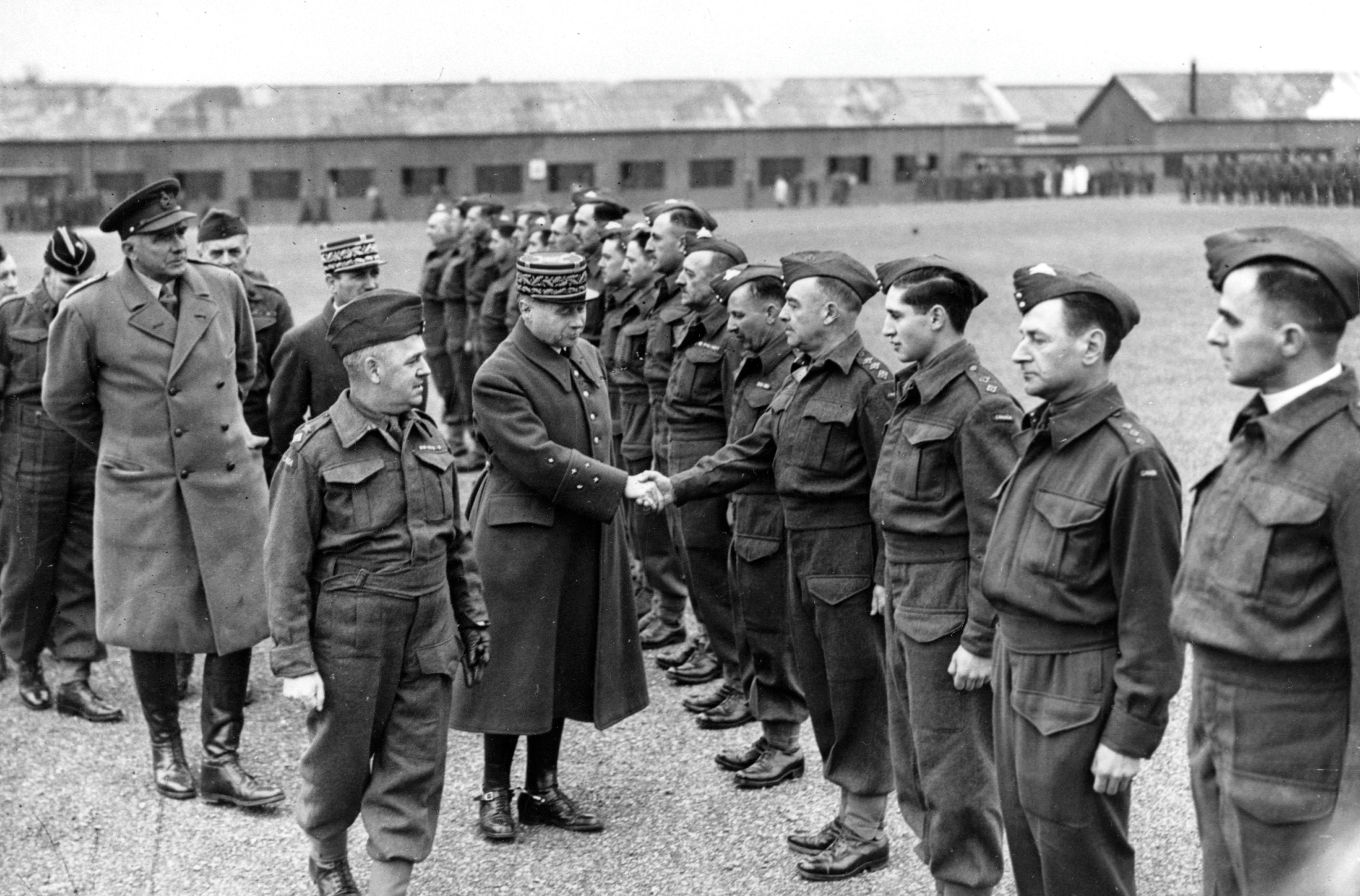
French General Maurice Gamelin inspects officers of the Royal 22nd Regiment on the grounds of the British army camp at Aldershot, England, on March 28, 1940. [LAC/PA-034165]
At this time, Canada was in the midst of a general election. King had promised that there would be a session of Parliament before the writ dropped, but when the House met on Jan. 25, he informed startled members that he was calling an election at once.
Mitchell Hepburn, the Liberal premier of Ontario and one of King’s bitter foes, was furious at what he considered the federal government’s desultory war effort. On Jan. 18, he had forced a motion through the Ontario legislature denouncing the King government. The prime minister seized on this to renege on his promise of a session, and he caught the Opposition short.
The election campaign was two months long, and the Liberals had it all their way. Hepburn notwithstanding, most Canadians seemed to believe the war effort was just fine, no one was calling for conscription, and the war in Europe was quiet—except for the three-month Winter War in Finland, where Soviet invasion forces faced fierce defenders in the bitter cold.
The election on March 26 resulted in a Liberal landslide. King won 181 of 245 seats and a majority of the popular vote. In Quebec, the party won an astonishing 63.3 per cent of the vote. King had been shrewd—and lucky—to get his election done and won before the spring.
On April 9, the Nazis attacked and occupied Denmark and launched assaults on Norway, ostensibly to stop the British and French from occupying the country. In fact, there had been Allied plans to intervene in Norway to get aid to Finland, but the plans ended with Helsinki’s surrender in March. Once the Germans occupied Norway’s capital Oslo and major ports, London and Paris were caught wrong-footed, and the subsequent expedition to Norway was grotesquely mismanaged.
On April 16, the War Office requested that McNaughton provide troops for an attack on Trondheim, Norway. Two days later, 1,300 men from the 2nd Canadian Infantry Brigade moved north to Scotland to await embarkation. Major Guy Simonds quickly prepared the orders.
The German hold on Norway was already so entrenched that Anglo-French efforts to drive them out failed with heavy losses. The still unready Canadians, their orders to embark soon cancelled, were fortunate to avoid the morass.
There was still heavy snow on the ground in Norway in mid-April and the divisional staff had scrambled to find winter clothing. One junior officer, Desmond Smith, discovered that British Army stocks were already depleted, so he called Lillywhites, a London sports clothing store, and purchased their entire stock of fleece-lined jackets at a high price. When the Canadian mission was scrapped, the bills came in, and McNaughton summoned Smith to explain himself. The general gave the young staff officer a bollocking, but then said, “To hell with rules, get it done, that’s the kind of young officer we want.” The men loved McNaughton.
The Germans, however, were just beginning. On May 10, the very day that Churchill became prime minister of Great Britain,
the Wehrmacht attacked Luxembourg, the Netherlands and Belgium and began to move armour around the Maginot Line defences and through the supposedly impassable Ardennes forests.
The Phoney War was over. The real war was about to begin.

Pictured in 1942, Lieutenant-General Andrew G.L. McNaughton was the dominant Canadian personality of the Phoney War in 1939-40. [LAC/3205306]
No better man
The dominant Canadian personality of the Phoney War was Major-General Andrew G.L. McNaughton.
McNaughton studied electrical engineering at McGill University, graduating in 1910. He joined the Canadian Militia in 1909 and led an artillery battery overseas in 1914 as a 27-year-old major. Wounded twice in early fighting, McNaughton recovered and rose rapidly, in 1917 becoming the Canadian Corps’ Counter Battery Staff Officer. He pioneered a sound-detection technique to locate enemy guns, helped make the Corps’ artillery a formidable force, and was a brigadier-general commanding the Corps’ heavy artillery at the war’s end.
He remained in the Permanent Force, attending the British Army Staff College and the Imperial Defence College and receiving glowing reports. In 1929, now 42, he became Chief of the General Staff, conceiving and organizing the army’s role in running relief camps for the unemployed during the Depression. In 1935, he went to the National Research Council as its president.
When war broke out in 1939, McNaughton quickly offered his services to the government and was soon named to command the First Canadian Division.
“I thought no better man could be selected,” said Prime Minister Mackenzie King.
McNaughton toured the country, visiting the troops, dealing with equipment shortages. His concern for his soldiers and his “red tape be damned” approach drew massive praise in the media. And when he went overseas, he impressed senior British officers with his intellect and drive.
“Every officer and everyone in the ranks worship him and trust him implicitly,” said one Canadian officer. That was certainly true in 1939-40, and McNaughton seemed destined for ever better things.
Advertisement





















